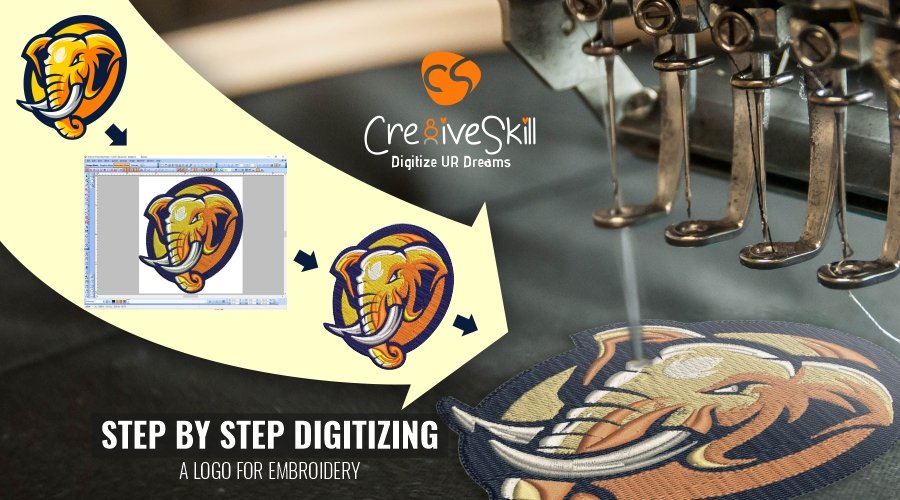Top-Rated Digitizing for Embroidery: Perfect Stitch Whenever
Top-Rated Digitizing for Embroidery: Perfect Stitch Whenever
Blog Article
Streamlining the Art of Embroidery Digitizing: Step-by-Step Overview
As modern technology continues to development, the digitization process has actually become more easily accessible, allowing enthusiasts to bring their complex designs to life with ease. In this overview, we will certainly unwind the complexities of needlework digitizing, breaking down each step carefully to improve the procedure and equip both beginners and seasoned embroiderers alike.
Recognizing Embroidery Digitizing Software
Needlework digitizing software application functions as an essential device for transforming complex designs right into digital layouts compatible with needlework makers, facilitating specific sewing and modification. This specialized software application enables individuals to import different photo documents styles, such as JPG or PNG, and transform them into embroidery machine-readable layouts like DST, EXP, or PES - Digitizing for Embroidery. By utilizing features like stitch editing and enhancing, rug options, and string shade choice, digitizing software program allows individuals to regulate every element of the design procedure
Additionally, progressed embroidery digitizing software program uses tools for producing intricate layouts, readjusting stitch thickness, and incorporating elaborate details. Users can likewise sneak peek the design before stitching it out, making sure precision and decreasing mistakes. Furthermore, many software application give automatic attributes that aid streamline the digitizing process, saving effort and time.
Understanding the capacities of embroidery digitizing software is important for attaining top notch cause needlework projects. By grasping this device, embroidery enthusiasts and professionals can unleash their creativity and bring elaborate designs to life with accuracy and efficiency.

Choosing the Right Style Documents
After familiarizing on your own with the capacities of needlework digitizing software, the following essential action in the procedure is choosing the right design apply for your project. Digitizing for Embroidery. When picking a design apply for embroidery digitizing, it's vital to consider the intricacy of the design, the size of the end product, and the sort of material you will be dealing with
For intricate layouts with great information, a high-resolution picture or vector documents is advised to make certain that the needlework machine can precisely duplicate the design. Additionally, the size of the final item plays a significant duty in picking the appropriate layout data. Larger designs might need greater resolution data to preserve quality and intensity.
Furthermore, the kind of material you will be stitching on affects the selection of design documents. Different textiles might require modifications in the design documents to ensure that the stitches are properly aligned and the style shows up as planned. web link By carefully selecting the right style data based upon these aspects, you can set on your own up for an effective embroidery digitizing procedure.
Digitizing Tools and Techniques
Using specialized software application and precision techniques, digitizing devices are essential in transforming detailed designs right into embroidery-ready data. Needlework digitizing software application, such as Wilcom, Hatch, or Embrilliance, supplies the essential system to transform artwork right into stitch information. These programs provide features like stitch modifying, rug options, and lettering tools to guarantee the design converts flawlessly onto textile.
One of the key methods in digitizing is developing a clear path for the needlework maker to comply with. This includes digitizing each element of the layout with accuracy, determining stitch kinds, densities, and instructions. By utilizing devices like digitizing tablets or software-specific plugins, embroiderers can attain a high degree of accuracy in their digitized layouts.
In addition, grasping the art of padding stitching is important for creating top quality embroidery. Underlay stitching supports the material and produces a foundation for the style, making certain that the end product is both aesthetically appealing and long-lasting. By understanding these digitizing tools and techniques, embroiderers can boost their craft and bring elaborate layouts to life with precision and performance.
Customizing Stitch Types and Directions
The choice of stitch types can substantially influence the general look and texture of the embroidered layout. By purposefully combining these stitch types, embroiderers can my response accomplish depth and measurement in their layouts.
Furthermore, the direction of stitches plays a critical duty in boosting the visual appeal of the last embroidery. By exploring with various stitch angles and patterns, embroiderers can bring their layouts to life with amazing information and ins and out.
Screening and Refining Your Digitized Style
To make certain the accuracy and quality of your digitized design, detailed testing and refinement are vital steps in the needlework digitizing process. When you have actually finished the digitization of your design, it is crucial to evaluate it before proceeding with the actual needlework. Testing permits you to recognize any prospective concerns such as thread breaks, sew thickness issues, or layout distortions that may affect the final outcome.

After testing, it is essential to fine-tune your digitized layout based on the responses from the test sew-out. This may involve tweaking sew setups, changing thickness, or making changes to the total layout to achieve the desired end result. By repeating via screening and improvement, you can adjust your resource digitized layout to excellence before progressing with the actual embroidery process.
Final Thought
In conclusion, understanding the art of needlework digitizing needs a complete understanding of the software application, picking the right design documents, making use of digitizing devices and methods, personalizing stitch kinds and directions, and screening and fine-tuning the digitized design. By complying with these actions, embroiderers can simplify the digitizing procedure and produce top notch stitched styles with accuracy and effectiveness.
Report this page